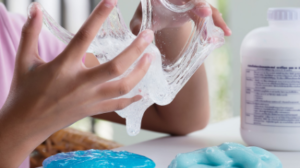Grosser is better when it comes to toys and crafts for kids. So, the craze for home-made slime is hardly surprising. Composed of household and cosmetic products not limited to white school glue, borax, and liquid detergents, the fad took off in early 2017. The practice, however, has prompted concerns since reports surfaced of second- and third-degree alkali burns caused by borax, a known contact irritant. And while only borax and the chemically similar boric acid have been known to cause irritant contact dermatitis, the other products may contain sensitizing preservatives and fragrances in unsafe concentrations, especially when used undiluted.
Moreover, because contact with the substances in slime is prolonged, the potential for irritation or sensitization is even greater.
Itchy and Painful Eruptions from Slime
Homemade slime poses many risks of acute and chronic hand dermatitis. For example:
- An 11-year-old non-atopic girl developed recalcitrant palmar vesicular dermatitis after contact with homemade slime over 2 months. Patch testing with a baseline and a cosmetic series elicited a strong positive reaction to methylchloroisothiazolinone/methylisothiazolinone (MCI/MI) 0.02% aqueous (aq), a main ingredient in the textile glue she had used, and a weak positive reaction to MI 0.02% aq alone.
- In another report, an otherwise healthy 7-year-old girl experienced pain, redness, and peeling of the palms the day after playing with homemade slime containing Tide detergent with bleach, glue, water, and a color marker.
- A 10-year-old girl suffered an itchy and painful eruption on the palms after intermittently playing with slime composed of glue, baking soda, shaving cream, contact lens solution, and food coloring over 4 days.
In the latter case, the likely culprit was the boric acid used as a preservative in the contact lens solution. Other symptoms such as swelling, tingling, and redness have been reported, as has severe blistering.
Homemade slime recipes usually include undiluted soap or detergent, which contains high levels of isothiazolinones. These preservatives can disrupt the skin barrier and cause cell membrane toxicity, as can other sensitizing preservatives such as alcohols and glycols.
Fragrances in these products, and in commercial play-gels, pose a risk as well: A 9-year-old atopic boy with persistent vesicular hand dermatitis had a strong positive reaction to paraben (16% in petrolatum) and a weak positive reaction to Myroxylon pereirae, possibly from the “potential presence” of methyl and ethyl parabens and fragrances in Play-Doh.
Delays in Diagnosis Lead to Severe and Persistent Hand Dermatitis
Early diagnosis of children with new-onset hand dermatitis by a trained dermatological clinician is critical to avoid needless suffering. Still, as a 2010 survey revealed, dermatological conditions ranked as the sixth principal diagnosis in all clinics, including primary care practices, representing 5% of the patients. Moreover, because differential diagnoses for hand eczema include fungal infections, herpes simplex, and scabies, among other diseases, effective treatment may be delayed by the prescription of unnecessary medications.
Before being referred to a dermatologist, a 9-year-old girl was treated for scabies and a culture-positive Staphylococcus aureus infection with a course of cephalexin and mupirocin ointment administered by her general practitioner. Her symptoms persisted. By the time she saw a dermatologist, the erythematous, scaly plaques on the palmar surfaces of both hands and on her volar fingertips had persisted for 5 months; she also had onychomadesis and longitudinal ridging on her fingernails. The progression of her condition complicated diagnosis because such clinical manifestations can mimic other causes of chronic hand dermatitis, such as atopic dermatitis, eczema, psoriasis, and dyshidrosis. In fact, with prolonged exposure to allergenic substances in slime, what started out as irritant contact dermatitis can lead to allergic contact dermatitis.
The good news? Since September, 2017, T.R.U.E. TEST has been FDA-approved for patients as young as 6 years old? (https://www.smartpractice.com/shop/wa/category?cn=Education-Contact-Dermatitis-News-December-2017%3A-Issue-22&id=582166&m=SPA)
Among the 35 T.R.U.E. TEST allergens included are the slime-related allergens MCI/MI, paraben mix, and balsam of Peru. Related individual allergens not on T.R.U.E. TEST, such as sodium lauryl sulfate 0.25 water (EE372) and propylene glycol 100 (NA96), are available from allergEAZE in easy-to-use patch test chambers and in syringes or tubes. Like adults, children deserve a diagnosis! To find out how you can more effectively provide one for your pediatric patients, call us at 1.800.878.3838.
Suggested Readings
Heller E, Murthy AS, Jen MV. A slime of the times: Two cases of acute irritant contact dermatitis from homemade slime. Pediatr Dermatol 2019;36(1):139-141
Aerts O, De Fré C, van Hoof T, et al. “Slime”: A new fashion among children causing severe hand dermatitis. Contact Dermatitis 2018;79(6):385-387
Asher C, Dalan R, Aly MI. “Home-made slime”: A novel cause for paediatric burns’ referrals; do we need to raise awareness? Burns 2018;44(6):1613
Gittler JK, Garzon MC, Lauren CT. “Slime” may not be so benign. J Pediatr 2018 Sep;200:288. doi: 10. 1016/j.peds.2018.03.064. Epub 2018 May 3.
Aerts O, Goossens A, Lambert J, et al. Contact allergy caused by isothiazolinone derivatives: an overview of non-cosmetic and unusual cosmetic sources. Eur J Dermatol 2017;27(2):115-122
Quah CHH, Koh D, Choon HH, et al. Approach to hand dermatitis in primary care. Singapore Med J 2012;53(11):701-704; quiz p. 705.








